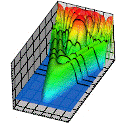Department of Physics and Astronomy: Publications and Other Research

Anthony F. Starace Publications
Document Type
Article
Date of this Version
10-1-1993
Abstract
A theory of the photodetachment of hydrogen negative ions in an external static electric field with the production of hydrogen in excited states is developed. We use a combination of the frame-transformation theory and the Green’s-function method. The cross section in nonzero fields is expressed in terms of the photodetachment matrix elements for zero field. The latter are calculated using the adiabatic hyperspherical representation. For energies close to the threshold we use a smooth extrapolation of the zero-field photodetachment matrix elements down to threshold taking care to enforce the proper threshold behavior of cross sections for nonzero fields. The ripples in the total cross section due to interference effects are not noticeable for incident photons linearly polarized along the static field direction, but are relatively well pronounced for the case of circularly polarized photons propagating along the static field. On the other hand, all partial cross sections corresponding to photodetached electrons having magnetic quantum number m’=0 (with respect to a quantization axis parallel to the static electric field) show significant ripple structure regardless of the light polarization. The partial cross section for detachment with excitation of the n=2, m=1 Stark substate by circularly polarized photons exhibits a particularly distinct ripple structure. All cross sections in the region of the shape resonance increase with increasing electric field in accordance with experimental observations. This effect is stronger in the case of linear polarization. We also predict a fairly stable value for the width of the 1P0 shape resonance as a function of the electric-field strength over the range from 0.4 to 1 MV/cm. For electric-field strengths below 0.4 MV/cm, the ripple structure in the shape resonance makes it difficult to define a resonance width.


Comments
Published by American Physical Society. Phys. Rev. A 48, 2968 (1993). http://pra.aps.org. Copyright © 1993 American Physical Society. Permission to use.